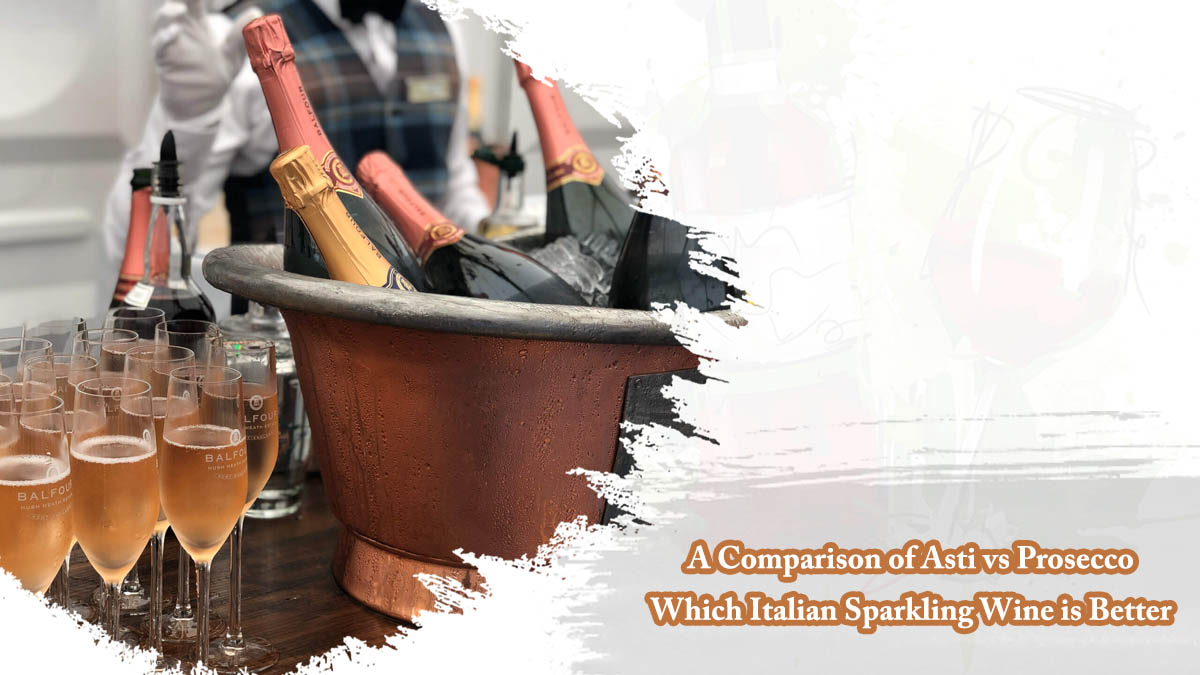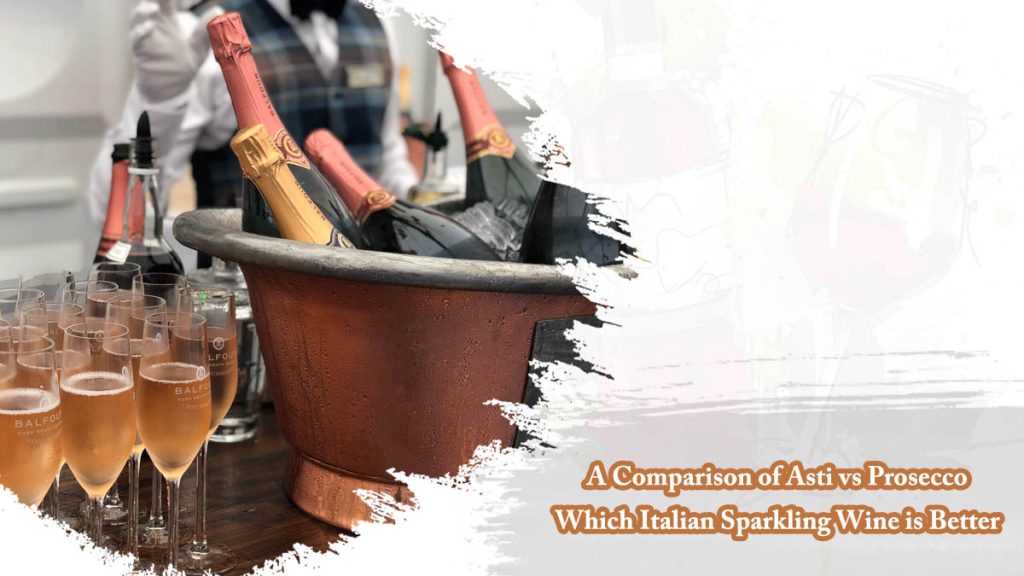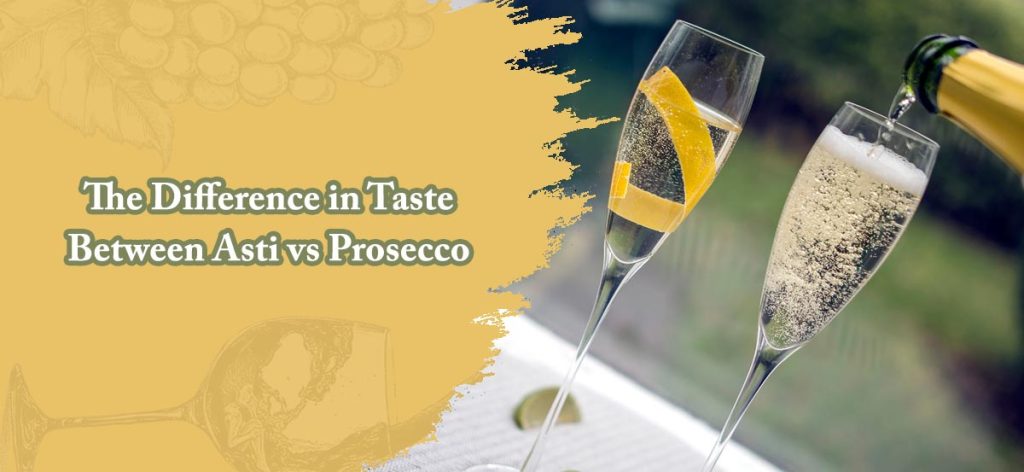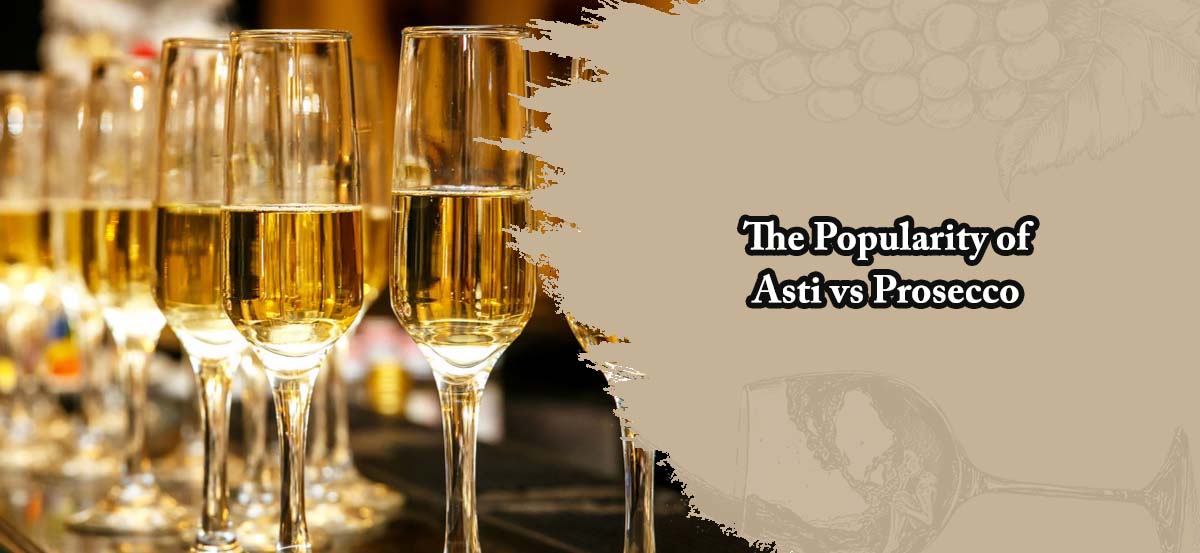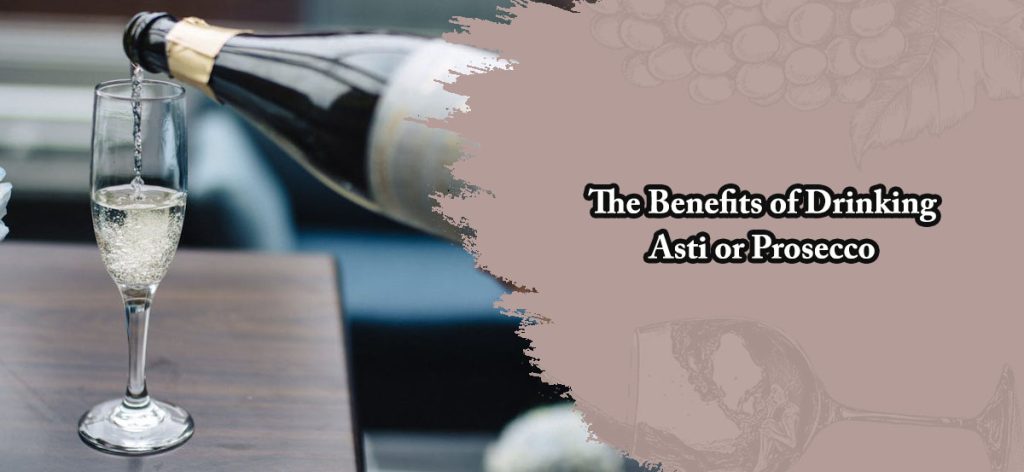Asti vs Prosecco
Asti and Prosecco are two popular Italian sparkling wines that have different characteristics and appeals. Asti (aks Asti Spumante) is a sweet, low-alcohol sparkling wine made with the Moscato Bianco grape variety in the Asti region of northwest Italy. Prosecco is a dry sparking wine made from the Glera grape variety grown primarily in the Veneto region of northeast Italy.
Both Asti and Prosecco have long been iconic Italian sparkling wines, each with its unique aroma, taste, and history. There is often debate about which type of sparkling wine should be consumed for certain occasions – but what makes these two different? Whether it be a special occasion or just an evening spent with friends, there is no doubt that these two delicious beverages can add something unique and special to any occasion. But for those who have not experienced the amazing tastes that both have to offer, the question remains: which one should you choose?
In this blog post, we’ll explore the complexities between Asti vs. Prosecco and identify differences in their respective production methods, nuances in flavor profiles, and recommended food pairings – allowing readers to decide for themselves which bubbly might best suit their palate or fit the occasion.
No matter if it’s an everyday gathering with friends or a non-negotiable special occasion – whatever the case may be, discover which Italian sparkler is right for your needs by reading on to learn all about the unique characteristics of Asti vs Prosecco.
Similarities Between Asti and Prosecco
Asti Spumante and Prosecco are two types of Italian sparkling wines that have some similarities, but also many differences. Asti is a sweet sparkling wine made in the Asti DOCG region of Piedmont while Prosecco is a dry, effervescent wine produced in both Veneto and Friuli Venezia Giulia regions. Despite their differences, there are several aspects where Asti and Prosecco share common ground.
Both Asti Spumante and Prosecco come from Italy’s renowned winemaking regions – Asti from Piedmont’s DOCG region and Prosecco from either Veneto or Friuli Venezia Giulia’s DOC region. This makes them popular choices for those looking to enjoy an Italian-style sparkling wine experience at home or at restaurants around the world.
Another similarity between Asti Spumante and Prosecco is that both are made using the Charmat method. This technique produces a bright flavor and aroma with just enough bubbles to make it enjoyable. Asti has a sweet, light taste while Prosecco tends to be dry and slightly acidic – making them perfect for different occasions.
Finally, Asti Spumante and Prosecco are incredibly versatile wines that can be paired with many different types of food. Asti’s sweetness makes it ideal for desserts while Prosecco pairs well with savory dishes like cheese or cured meats. They can also be served as an aperitif before a meal or as a refreshing beverage on their own.
In conclusion, Asti Spumante and Prosecco may have their differences, but they share several similarities that make them both popular Italian sparkling wines. From the DOCG region Asti is produced into the Charmat method used to create them, Asti and Prosecco are sure to please any palate seeking an enjoyable Italian wine experience.
The Difference in Taste Between Asti vs Prosecco
A Comprehensive Guide to Asti Spumante
Asti Spumante is a sparkling Italian wine that has become increasingly popular in the United States. To truly appreciate the unique characteristics of this delicious and aromatic beverage, let’s take a closer look at its aroma, body, tannin levels, acidity, and alcohol content.
Aroma: The aroma of Asti Spumante is often described as sweet and distinct, with notes of peach, pear, flowers, citrus, and green apples being present. It’s considered to be one of the more aromatic wines out there and can easily be distinguished by its strong scent.
Body: The body of Asti Spumante ranges from light to medium-bodied depending on the vintage or blend. It has a crisp yet refreshing mouthfeel that is sure to please any palate.
Tannin Levels: This sparkling wine contains low tannin levels which give it a smooth and easy drinking quality. This allows for the other flavors to shine through without being overwhelmed by harsh tannins.
Acidity: Asti Spumante is known for having a bright acidity that gives it a refreshing finish when sipped on. The acidity also helps to balance out any sweetness in the flavor profile making it an excellent option for those who prefer their wines not too sweet.
Alcohol Content: While there is no standard alcohol content set by law, most bottles contain around 7-9.5% ABV making them light enough to enjoy during lunch or dinner without feeling overly heavy or intoxicated afterward.
Asti is truly an exceptional sparkling wine made with care and attention to detail by some of Italy’s finest winemakers. Its delicate balance between sweetness, acidity, tannins, and alcohol makes it a great choice for any occasion or meal whether you are looking for something light and refreshing or something more robust and bolder in the flavor profile.
A Comprehensive Guide to Prosecco Characteristics
When it comes to sparkling wine, few beverages are as popular or as beloved as prosecco. This Italian sparkling white wine is a favorite among many for its smooth taste and refreshing flavor profile. But what makes prosecco so special? What characteristics set it apart from other types of sparkling wines? In this blog post, we’ll explore the unique characteristics of prosecco and why they make it so delicious.
Aroma: One of the most distinctive characteristics of prosecco is its aroma. Prosecco aromas are simply remarkable. Premium bottles of Prosecco feature fragrances of banana cream, tropical fruits, vanilla, hazelnut, and honeycomb. It’s also known for having an intense aroma that can fill a room quickly.
Body: The body of prosecco can range from light to medium-bodied, depending on the type and style. Generally speaking, Brut styles tend to be more full-bodied than Extra Dry styles and have higher alcohol levels. As far as sweetness goes, Brut has very little sweetness while Extra Dry has a slightly sweet aftertaste.
Tannin Levels: Prosecco does not contain any tannins because it is not aged in oak barrels like other types of wines. This means that it doesn’t have any bitter or astringent flavors as some other wines do. Instead, its flavor profile is dominated by fruity notes such as citrus and stone fruits.
Acidity: Prosecco has high levels of acidity due to the grapes used in production being predominantly high-acid varieties like Glera and Pinot Grigio. This acidity helps to balance out the sweetness of the wine and adds complexity to the final product.
Alcohol Content: The alcohol content in prosecco typically ranges between 11% – 13%, making it slightly lower in alcohol than most wines but still enough to give you a buzz if you drink too much! This low alcohol content also helps explain why this bubbly beverage pairs so well with food – it won’t overwhelm your palate or overpower your meal as some stronger alcoholic beverages would!
All in all, many characteristics make prosecco stand out from other types of sparkling wines – from its floral aroma to its high acidity levels and low alcohol content.
Summary:
Asti and Prosecco are both popular Italian sparkling wines, each with its unique characteristics. Asti is a sweeter, lighter-bodied style of sparkling wine that has low tannin levels but plenty of bright acidities. It typically has an ABV of 7-9.5%, making it light enough to enjoy without feeling overly heavy or intoxicated afterward.
Prosecco is also a light-bodied sparkling wine but tends to be slightly fuller than Asti with more complexity in the flavor profile. Its alcohol content ranges between 11% – 13% and it is known for its intense fragrances of tropical fruits, vanilla, and honeycomb.
Asti is an excellent choice for those who prefer their wines not too sweet while Prosecco works well for those looking for something a bit sweeter with a subtle sweetness on the finish.
Both Asti and Prosecco offer great food pairing options as their low alcohol content allows them to compliment the flavors in a dish without overpowering them.
Read more about Prosecco and Cava.
How Asti is Made vs How Prosecco is Made
How Asti is Made?
Asti is made using two types of grapes: Moscato Bianco and Moscato Giallo. The Moscato Bianco grape is large and oval-shaped with a greenish-yellow hue. The Moscato Giallo grape is smaller and more round with a yellowish color. Together, these grapes create a wine that is light, sweet, and refreshing.
Asti undergoes a process called Charmat method fermentation. This involves pumping the newly pressed grape juice into sealed tanks where it can ferment in isolation from the outside air. This process allows for a slow and controlled fermentation which helps to preserve the delicate flavors of the Moscato grapes.
Once fermentation is complete, the wine is bottled under pressure which gives it its signature bubbles.
There are a few things that make Asti special. Firstly, it can only be made in certain areas of Italy which gives it a sense of place and terroir. Secondly, the Charmat method of fermentation helps to preserve the delicate aromas and flavors of the Moscato grapes. Lastly, its light sweetness makes it incredibly versatile and food-friendly.
Asti is a delicious sparkling wine that has been enjoyed for centuries. It’s made using two types of grapes (Moscato Bianco and Moscato Giallo) and undergoes Charmat method fermentation to preserve its delicate flavors.
How Prosecco is Made?
Prosecco is made from Glera grapes, which are harvested by hand in early September. The grapes are then sorted for quality and size before being placed into stainless steel tanks where they undergo a cold fermentation process for about 10 days. This process helps to preserve the fresh fruit aromas that are characteristic of prosecco.
Once the primary fermentation is complete, the wine must undergo a second fermentation to create its signature bubbles. This secondary fermentation takes place in pressurized tanks known as autoclaves, or “Charmat” tanks, where carbon dioxide gas is injected into the wine under pressure. This process creates tiny bubbles that give prosecco its signature sparkle and flavor. The amount of time it takes for this secondary fermentation can vary depending on how much carbon dioxide is desired in the final product. For example, a sweeter prosecco will require more time than one that is drier.
After it undergoes a secondary fermentation, the prosecco must be bottled quickly to prevent it from losing its bubbles and becoming flat. The bottles are then corked and stored horizontally so that sediment does not settle at the neck of the bottle – this sediment comes from dead yeast cells used during fermentation and can give off bitter flavors if disturbed during pouring or drinking! After bottling, some producers may choose to age their prosecco for several months before it hits shelves – however, many opt not to do this as aging can alter both flavor and aroma profiles of sparkling wines like Prosecco.
Prosecco production requires careful attention to detail at every step of production – from harvesting Glera grapes by hand through pressing them into juice, fermenting them twice with different yeasts, bottling quickly to maintain carbonation levels, and finally aging (or not) before the sale.
What is the Charmat Method?
The Charmat method, also known as the Martinotti–Charmat method, is a process used to make sparkling wine. It is named after its inventor, French engineer Eugène Charmat. The Charmat method is also sometimes called the tank method because it uses a pressurized tank to carbonate the wine. This is in contrast to the Champagne method, which uses the bottle itself to carbonate the wine.
The Charmat method is faster and less expensive than the Champagne method, which is why it is more commonly used to make mass-produced sparkling wines. That said, there are some drawbacks to the Charmat method. One is that it can produce a less complex flavor than the Champagne method. Another is that it can strip away some of the aromatics from the wine.
The Charmat method begins with a still wine base that has been made in the same way as any other still wine. The base wine is then fermented a second time in a pressurized tank with yeast and sugar. This secondary fermentation produces carbon dioxide, which dissolves into the wine and makes it bubbly.
After secondary fermentation is complete, the wine is cooled and bottled under pressure. The pressure keeps the carbon dioxide dissolved in the wine, giving it its bubbles. Some of the yeast will be trapped in the bottle along with the carbon dioxide, which can give the finished wine a slightly yeasty flavor.
The Charmat method is typically used to make sparkling wines that are meant to be consumed young and fresh, such as Prosecco, and Asti. Wines made using this method are usually light-bodied with fruity flavors and aromas.
The Charmat method is a process used to make sparkling wine. It was invented by French engineer Eugène Charmat and is also sometimes called the Martinotti–Charmat or tank method. The Charmat method uses a pressurized tank to carbonate the wine, as opposed to using bottles like in the method traditionelle or Champagne method.
Summary:
Asti and Prosecco are two Italian sparkling wines made with different grapes, but they both undergo a process of fermentation to create their signature bubbles. Asti is made using Moscato Bianco and Moscato Giallo grapes which are fermented using the Charmat method in sealed tanks. This method helps to preserve the delicate aromas and flavors of the grapes without over-fermenting them.
Prosecco, on the other hand, is made from Glera grapes which are processed using a primary fermentation followed by a secondary fermentation in pressurized tanks known as autoclaves or “Charmat” tanks. Carbon dioxide gas is injected into the wine under pressure during this process, creating tiny bubbles that give prosecco its signature sparkle and flavor. After bottling, some producers may choose to age their prosecco for several months before it hits shelves – however, many opt not to do this as aging can alter both flavor and aroma profiles of sparkling wines like Prosecco.
All these steps require careful attention to detail to produce Asti and Prosecco according to traditional methods while preserving their unique characteristics.
The Popularity of Asti vs Prosecco
The Popularity of Asti
Asti is a sparkling white Italian wine made with the Moscato Bianco grape. This light and refreshing beverage have become increasingly popular in recent years, and it’s easy to see why. From its crisp flavor profile to its versatility as an aperitif or dessert wine, Asti offers something for everyone who enjoys a glass of vino.
At the heart of Asti’s appeal is its flavor profile. The Moscato grapes used to create this sweet beverage are balanced by notes of citrus and peach that make it taste like a summer day infused into a bottle. It also boasts an inviting floral aroma, which lends itself well to many types of food pairings. All these wonderful characteristics have helped make Asti one of the most popular sparkling wines on the market today.
Another factor in Asti’s rise to fame is its versatility as an aperitif or dessert wine. Its sweetness makes it ideal for pre-dinner drinks or after-dinner treats, while its low alcohol content (around 7% ABV) means that you can enjoy more than one glass without feeling overly intoxicated—which makes it perfect for social gatherings! Plus, since it comes in both still and sparkling varieties, you can choose whichever type best suits your needs.
Finally, there’s the price point; compared to other wines, Asti tends to be fairly affordable but still retains excellent quality. This makes it ideal for those who want to enjoy good wine without breaking the bank. As such, its popularity has grown among both experienced wine drinkers and newcomers alike!
Overall, there are many reasons why Asti has become so popular over time—from its flavor profile and versatility as an aperitif or dessert wine to its affordability.
The Popularity of Prosecco
Prosecco has become increasingly popular in recent years, to the point where it’s now one of the most popular drinks in the world. But how did prosecco become so popular?
The first reason for Prosecco’s popularity is its price. Prosecco is an affordable alternative to Champagne, which can be quite expensive. This makes it a popular choice for special occasions like weddings and anniversaries. Additionally, prosecco is often used as a mixer for cocktails, which makes it a versatile drink that can be enjoyed in many different ways.
Another reason for prosecco’s popularity is its taste. Many people find prosecco to be sweeter and less acidic than Champagne, which makes it more palatable for some. Additionally, because prosecco is made with grapes that are native to Italy, it has a unique flavor that sets it apart from other sparkling wines.
Finally, prosecco has benefited from some savvy marketing in recent years. Many brands have capitalized on the trend of using champagne flutes for cocktails by releasing their line of prosecco cocktails. This has helped to make prosecco even more popular with young people who are looking for something new and exciting to drink.
There’s no doubt about it – Prosecco is here to stay. Thanks to its affordable price, unique flavor, and versatile nature, this sparkling wine has taken over the world in recent years.
Food Pairings for Asti and Prosecco
Perfect Food Pairings for Asti
Asti is a sparkling Italian wine that is known for its sweet, light flavor. It’s an excellent choice for those who prefer sweeter wines and want to try something new. But what does one pair with Asti to enhance the flavor profile?
Cheese and Fruits – Asti pairs particularly well with cheese and fruits. The sweetness of the Asti complements soft cheeses like Brie or Camembert, while sharper cheeses like Parmigiano Reggiano bring out the complexity of the wine’s flavor. Fruits that are high in acidity, such as apples and pears, are especially delicious when paired with Asti. These fruits will help balance out the sweetness of the wine while still allowing it to shine through.
Seafood – The lightness of Asti makes it a great option for seafood dishes such as grilled salmon or shrimp scampi. The sweetness will also help to cut through any fishy flavors in your dish, making it more enjoyable to eat. Additionally, if you have a creamy seafood dish like crab cakes or mussels in white sauce, Asti can bring out all the subtle nuances that make these dishes so delicious.
Desserts – When it comes to desserts, nothing pairs better with Asti than chocolate-based treats such as brownies or truffles. The richness of chocolate goes perfectly with the sweetness of Asti and creates an indulgent combination that will leave you wanting more! If you’re looking for something a bit lighter after dinner, a fruit tart or lemon meringue pie would also be an excellent option for pairing with this type of wine.
Whether you’re trying to find a unique pairing for your next dinner party or simply want to enjoy some good food and wine on your own, exploring food pairings with Asti is a great way to go about it!
Perfect Food Pairings for Prosecco
This bubbly beverage is often served as an aperitif before dinner and is best enjoyed when paired with the right food. Here are some of the best dishes to pair with this delicious Italian favorite!
Salads – When it comes to pairing prosecco with food, salads are always a great choice. Salads like Caesar salad, Greek salad, or even a simple green salad are all excellent options because they’re light and refreshing. The acidity in the vinaigrette will help bring out the flavor of the prosecco, while also providing enough substance to satisfy your hunger!
Seafood Dishes – Another great pairing option for prosecco is seafood dishes. Seafood like shrimp, scallops, salmon, and clams all pair perfectly with this bubbly beverage. The delicate flavors of these dishes will not overpower the subtle sweetness of prosecco but rather enhance its flavor giving you an unforgettable culinary experience!
Cheeses – If you’re looking for something a little more substantial than just salads or seafood dishes then cheese might be your best bet. Cheese pairs well with almost any type of wine so it’s no surprise that it also goes well with prosecco! Hard cheeses like parmesan or goat cheese have bolder flavors that can stand up to the sweetness of this sparkling wine while softer cheeses such as brie or camembert provide a milder flavor profile which makes them perfect complements for prosecco.
No matter what kind of food you decide to pair with your bottle of prosecco there are plenty of options available that will make it an enjoyable experience. From salads to seafood dishes and even cheese plates – there’s something out there that everyone can enjoy!
The Benefits of Drinking Asti or Prosecco
There are several health benefits associated with drinking Asti or Prosecco. Let’s take a deeper look at how these drinks can benefit your health.
Benefits for the Skin
Asti and Prosecco both contain antioxidants, which can help protect the skin from damage caused by UV rays and other environmental factors. These antioxidants also help promote collagen production, making your skin more elastic, hydrated, and less prone to wrinkles. In addition, both drinks contain high levels of vitamin C, which can help boost your immune system and protect against bacteria on the skin.
Benefits for the Heart
Both Asti and Prosecco contain flavonoids, which are compounds found in certain plant-based foods that may have protective effects on the heart. Studies have shown that people who regularly drink Asti or Prosecco have a lower risk of developing coronary artery disease than those who do not drink either beverage. Additionally, they also have lower levels of bad cholesterol (LDL) compared to those who don’t drink either type of wine. This means that drinking either type of wine regularly could potentially reduce your risk of developing heart disease over time.
Benefits for Digestion
Finally, both Asti and Prosecco can be beneficial for digestion because they both contain probiotic bacteria which can help improve gut health by aiding in digestion and absorption of nutrients from food. Additionally, these beverages also contain polyphenols which are compounds known to reduce inflammation throughout the body including in the digestive tract. This could lead to improved overall digestive health as well as better nutrient absorption from food consumed.
All in all, drinking either type of wine can offer numerous health benefits ranging from improved skin quality to reduced risks of coronary artery disease to better digestive health overall.
FAQs
1. What is Asti?
Asti is an Italian sparkling wine made from Muscat Blanc grapes. It is a crisp and light-bodied sweet wine with aromas of apples, honey, and white flowers. Asti is one of the most famous sparkling wines in Italy and it has a very distinct flavor that sets it apart from other sparkling wines.
2. What is Prosecco?
Prosecco is another type of sparkling Italian wine made from Glera grapes grown mainly in the Veneto region of Italy. Prosecco has a dry, fruity taste with notes of green apple, pear, and citrus fruits. It’s light-bodied and refreshingly bubbly like Asti but not as sweet or rich in texture as Asti can be.
3. How are Asti and Prosecco made?
Asti and Prosecco wines are both made using the traditional method of fermentation, meaning that the wine is fermented in tanks before being bottled. Asti also goes through a secondary fermentation process called Charmat, which gives Asti its distinctive bubbly texture. On the other hand, Prosecco uses a simpler technique called the tank method for fermenting its wine in bulk without the need to bottle each batch separately.
4. How do Asti and Prosecco differ in sweetness levels?
Asti tends to be sweeter than Prosecco because of the additional sugar added during production while Prosecco has more of a dry finish with less sweetness but still retains some fruity notes from the grapes used to make it.
5. Are Asti and Prosecco gluten free?
Asti and Prosecco are both gluten-free wines.
6. Is Asti or Prosecco typically more expensive?
Asti is typically more expensive than Prosecco due to the added time and labor costs involved in producing it through a secondary fermentation process.
7. Should Asti or Prosecco be served chilled or at room temperature?
Asti should be served chilled while Prosecco can be served either chilled or at room temperature depending on personal preference.
8. Does aging affect the taste of Asti and/or Prosecco wines?
Aging will not significantly affect the taste of Asti or Prosecco wines as they are both meant to be consumed young, but extended aging may result in a slight change in flavor profile over time.
9. What type of food goes well with Asti or Prosecco wines?
Asti and Prosecco pair well with light dishes such as salads, seafood, vegetables, fruit dishes, soft cheeses, and desserts.
10 . Are there any health benefits to consuming Asti or Prosecco wines?
Asti and Prosecco wines may offer some health benefits such as reducing the risk of heart disease and stroke due to their moderate alcohol content, and the presence of antioxidants, and polyphenols. These sparkling wines have also been linked with helping reduce cholesterol levels in the blood. However, it is important to note that these potential benefits should only be enjoyed in moderation as excessive drinking can lead to negative side effects including liver damage.
Conclusion
All in all, readers have seen that there are many distinctions between Asti and Prosecco. It is important to remember that these two wines differ in their origin, sweetness level, aroma, production characteristics, and color. However, knowing the differences can be advantageous when selecting a truly amazing bubbly wine to match a momentous occasion or just to enjoy as part of a weekend. Readers should take some time to take into consideration all of the characteristics presented here when deciding what sparkling Italian wine to choose.
Thank you for taking the time to read this informative blog post–without our readership, we couldn’t continue to put out meaningful content like this! Be sure to follow our blog for more great articles on different kinds of wines from around the world. And don’t forget, no matter which type of Sparkling Italian Wine you choose come a celebratory time–Saluté!
Visit our Website for more interesting posts.

I am Thomas Delange, CEO of McMahon’s Public House bar. I have a passion for restaurants and cooking & wines, and I love to spend my free time experimenting in the kitchen. I’ve worked hard to make McMahon’s one of the most successful bars in the city. When I’m not working, I enjoy spending time with my friends and family.

